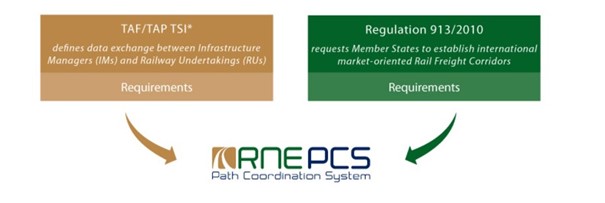The RNE Path Coordination System must meet two main legal requirements. On the one hand, TAF/TAP TSI defines the data exchange between Infrastructure Managers (IMs) and Railway Undertakings (RUs). On the other hand, Regulation 913/2010 requests the Member States of the European Union to establish international market-oriented Rail Freight Corridors (RFCs).

PCS and TAF/TAP TSI
The Path Coordination System is the first timetable coordination system that fulfills TAF/TAP TSI requirements.
- Processes have been implemented
- Messages are supported
- Formats defined in TAF TAP TSI are implemented in PCS
- TAF/TAP TSI reference files can be used.
Furthermore, PCS has been preconditioned for TAF/TAP TSI implementation and is able to communicate via a Common Interface (CI). The compatibility of PCS and TAF/TAP TSI has been checked and approved by the European Railway Agency (ERA).
Regulation 913/2010
PCS is key to fulfilling Regulation 913/2010 requirements as it delivers the following functionalities for the Rail Freight Corridors:
- PCS handles Pre-arranged Path (PaP) requests and supports path allocation and management of reserved capacity for ad-hoc path requests on RFCs.
- PCS helps the Corridor One-Stop-Shops (C-OSS) fulfil their capacity allocation tasks on corridors.
- PCS provides a transparent path request and path allocation process, which may be evaluated by Regulatory Bodies (RBs).
Future developments of functionalities of PCS will take the requirements of regulation 913/2010 into account to amend and improve the application according to future legal and business requirements.